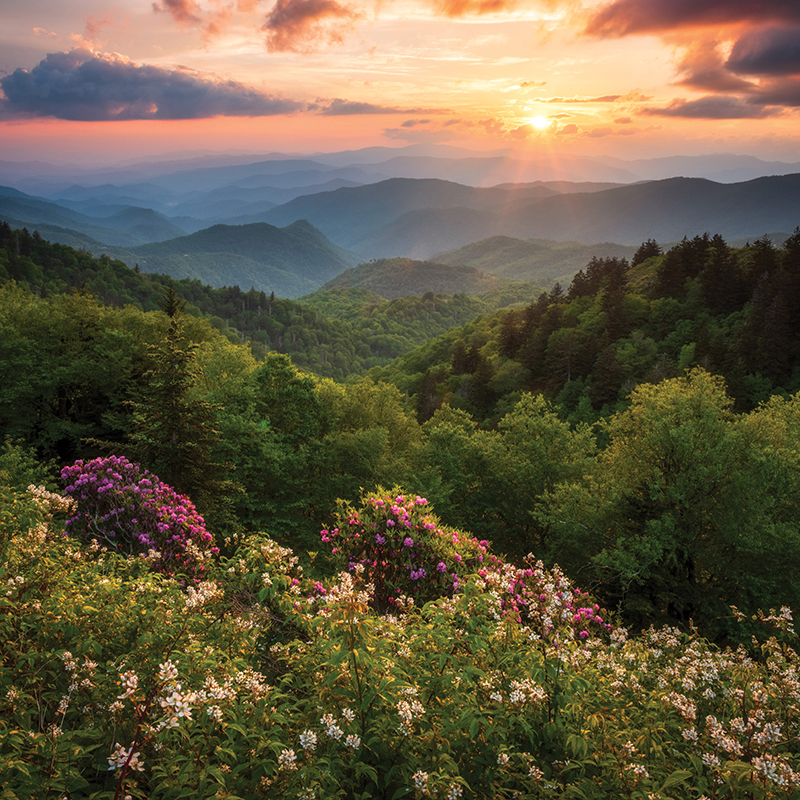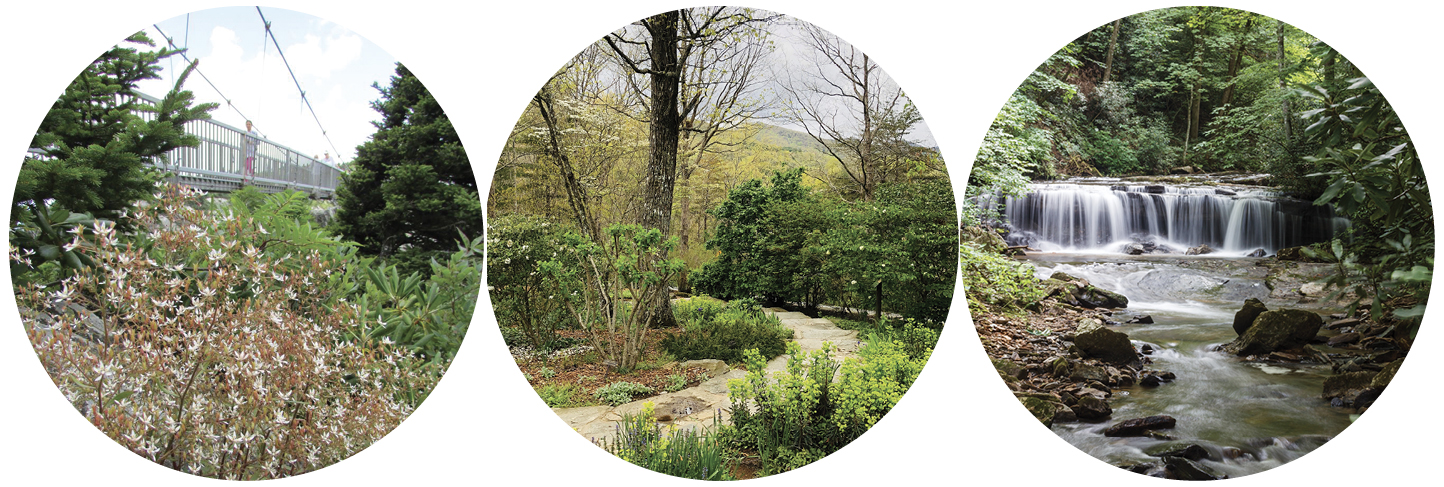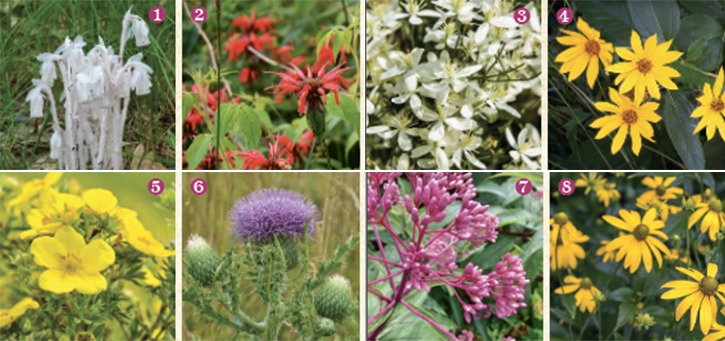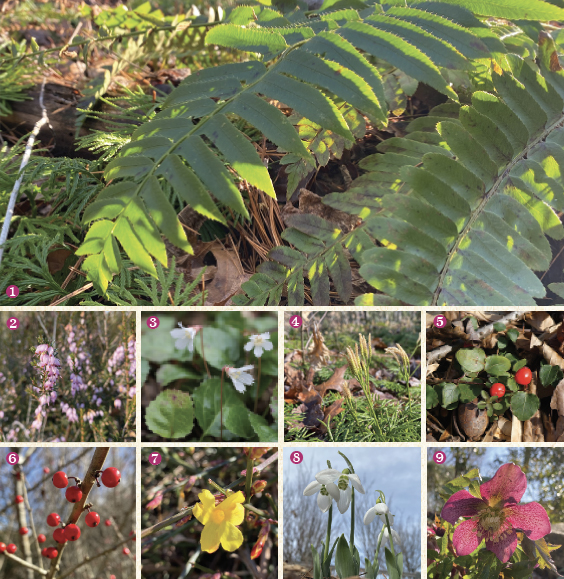Bloomin' Wild
Bloomin' Wild: Strike out to discover native floral treasures in WNC

Not just a springtime phenomenon, when pastel blooms carpet the forest floor, wildflower season circles the calendar: from ground-hugging wintergreen that defies January’s ice and snow, to gaudy meadow plants reaching skyward all summer, to cheery witch hazel blooms that brighten gray December woods. Even the tallest “wildflowers,” flowering trees like tulip poplar, mountain magnolia, and silverbells, are among Western North Carolina’s native blooming beauties.
Spring may be the most glorious of all the wildflower seasons in WNC, but finding beautiful blooms is less about specific dates than about matching plants with places. Every square mile of WNC has a different combination of altitude, moisture, sun, and soil type—remnants of the last Ice Age. “Spring” may begin in early March in one place, while just a few miles away it starts in late May. So tailor wildflower expeditions to personal preferences, whether that means steep, rocky climbs or a leisurely stroll. When looking for native flowers to establish in the home landscape, find terrain and conditions as close as possible to your own.
While wildflowers can be spotted on most any trail across the region, a few areas are particularly noteworthy, such as Elk Knob State Park near Boone. In addition to breathtaking panoramic summit views, the park’s bloom calendar lists hundreds of wildflower species in May and June alone—though the biggest wow may be a blaze of native flame azaleas.
“The Backcountry Trail area is covered in wildflowers mid April,” reports park ranger Brandy Belville. “We get trilliums along the first half of the Beech Tree Trail, and some on the Summit Trail, in early May.” And though she recommends calling the park to confirm the specific timing on the flame azalea display, she says, “On average, they are in full bloom around mid-June.”
Elsewhere, Crabtree Falls trail on the Blue Ridge Parkway, near Little Switzerland, is perfect for spring wildflower viewing. The North Carolina Arboretum in Asheville features thousands of native flowering plants in spring. And the spectacular Catawba rhododendron bloom spreading over Roan Mountain, along the North Carolina/Tennessee state line, peaks in mid to late June. Another brilliant display of rhododendrons occurs at Craggy Gardens along the Blue Ridge Parkway, generally peaking in early to mid June. Far western Graham County is noted for its lush blooms of native azaleas, while Biltmore Estate, better known for its formal gardens, has patches of wildflowers around the estate most of the year.
National and state forestland stretches across WNC, and extensive trail systems offer opportunities for wildflower viewing. Pink Beds Trail in Pisgah National Forest is famous for its accessibility to a range of native species, while Grandfather Mountain State Park showcases high-altitude plants that thrive in rocky conditions year-round. Great Smoky Mountains National Park offers numerous wildflower habitats and easy access.
As the weather warms and life begins anew, it’s a great time to grow your knowledge and appreciation for WNC’s wild blooms. Within these pages, we offer plant identification inspiration—a mere fraction of the hundreds of flowers you may encounter—plus resources to help you along the way.

Spring & Summer Wildflowers
❶ Goatsbeard (Aruncus dioicus) a herbaceous perennial
❷ Mayapple (Podophyllum peltatum) common in deciduous forests
❸ Cardinal Flower (Lobelia cardinalis) native to the Americas
❹ Frazier Magnolia (Magnolia fraseri) aka mountain magnolia
❺ Milkweed (Asclepias syriaca) a perrenial herb
❻ Firepink (Silene virginica) blooms beginning late spring
❼ Jack in the Pulpit (Arisaema triphyllum) a woodland wildflower
❽ Tiarella (Tiarella cordifolia) often grown in gardens
❾ Trout Lily (Erythronium americanum) aka yellow dogtooth violet
❿ Heller's Blazing Star (Liatris helleri) native to Appalachian Mtns.

Wildflower Happenings - Seasonal wildflower festivals, workshops, and scheduled hikes are hallmarks of WNC outdoor life
Elk Knob State Park (Meat Camp) has ranger-led wildflower hikes from late April through May, and herbal programs in late summer. ncparks.gov
Grandfather Mountain (Linville) offers guided wildflower hikes, with two weeks’ notice required for reservations and a minimum of two persons. Contact hiking@grandfathermtn.com or call (828) 737-0833. grandfather.com
Graham County Native Azalea Festival (Robbinsville) usually takes place over two weeks in early and mid June. More details TBA. nativeazaleafestival.com
Annual Ramp Festival (Waynesville) is held around the first of May. This “wild leek” is a pungent woodland delicacy, but when left wild, it blooms in a profusion of delicate white flowers.
visitncsmokies.com
The North Carolina Arboretum (Asheville) has miles of hiking and biking trails—graded easy to difficult—for getting close to wildflowers, including a National Native Azalea collection and a rhododendron thicket. Check the website for a full description of classes, exhibits, and symposia. ncarboretum.org
Transylvania County Wildflower Walks (Brevard) are four suggested hikes taking in spectacular scenery and countless wildflowers; three are in Pisgah National Forest, the other in Gorges State Park. explorebrevard.com
Pearson’s Falls & Glen (Tryon) is operated by the Tryon Garden Club as a public service. Groups of any age are welcome to tour this wildflower-studded glade; docent-led walks are by reservation. pearsonsfalls.org

Fall Wildflowers
❶ Indian Pipe (Monotropa uniflora) aka Ghost Pipe
❷ Scarlet Bee Balm (Monarda didyma) an aromatic herb
❸ Virgin's Bower (Clematis virginiana) an invasive vine
❹ Thin-leaved Sunflower (Helianthus decapetalus ) attracts bees and butterflies
❺ Evening Primrose (Oenothera biennis) traditional medicinal plant
❻ Field Thistle (Cirsium discolor) a native biennial
❼ Joe-pye Weed (Eupatorium purpureum) loved by pollinators
❽ Cutleaf Coneflower (Rudbeckia laciniata) thrives in wet sites

Winter Wildflowers
❶ Christmas Fern (Polystichum acrostichoides) stays green year-round
❷ Winter Heath (Erica carnea) heavy blooms in winter
❸ Oconee Bell (Shortia galacifolia) blooms mid March to early April
❹ Groundcedar (Diphasiastrum digitatum) aka fan clubmoss
❺ Partridgeberry (Mitchella repens) a trailing evergreen herb
❻ Possumhaw Holly (Ilex decidua) the berries are poisonous to humans
❼ Winter Jasmine (Jasminum nudiflorum) native to China
❽ Giant Snowdrop (Galanthus elwesii) blooms February to March, even in snow
❾ Lenten Rose (Helleborus x hybridus) begins blooming circa February

Flower Power - Five great resources to grow your native wildflower wisdom
From classic wildflower reference books to up-to-date smartphone apps, nature lovers can delve into a wealth of resources as they take to woods and meadows in search of beautiful blooms. Also consider attending one of the many classes, workshops, and symposia offered in WNC.
1 - By the Book Arthur Stupka’s Wildflowers in Color is a classic teaching aid; Peterson Field Guide to Wildflowers, while targeted to the Northeast, covers many Appalachian species as well; WNC resident Tim Spira enriches the field with Waterfalls and Wildflowers in the Southern Appalachians: Thirty Great Hikes; and even plant professionals take along Dennis Horn’s and Tavia Cathcart’s Wildflowers of Tennessee, the Ohio Valley, and the Southern Appalachians.
2 - Web Connection iNaturalist.org is an online community that shares observations about the natural world and learns from others. Give it a try.
3 - Join the Club Draw on the experience of local plant enthusiasts and find wildflower events via Friends of the Smokies, Carolina Mountain Club, and the North Carolina Native Plant Society.
4 - App-titude Great smartphone apps for plant identification include PlantNet, LeafSnap, PictureThis, and the lively PlantSnap.
5 - Back to Class Teaching gardens in WNC include The North Carolina Arboretum in Asheville; the Cullowhee Native Plant Conference, sponsored by Western Carolina University; the Botanical Gardens at Asheville; and Highlands Botanical Gardens, close to downtown Highlands.